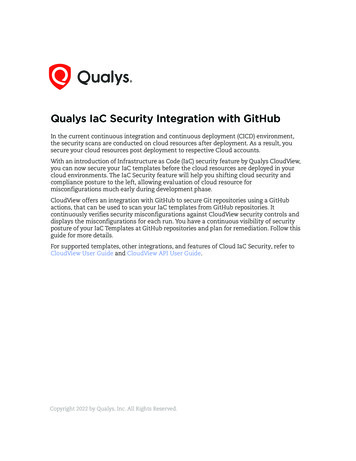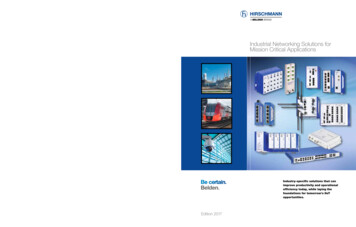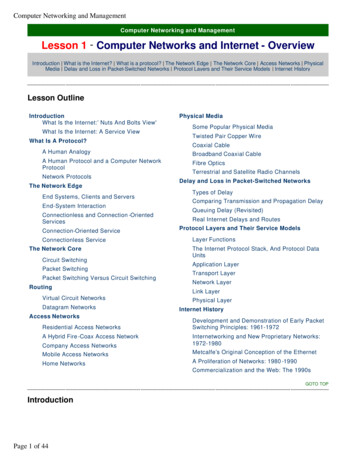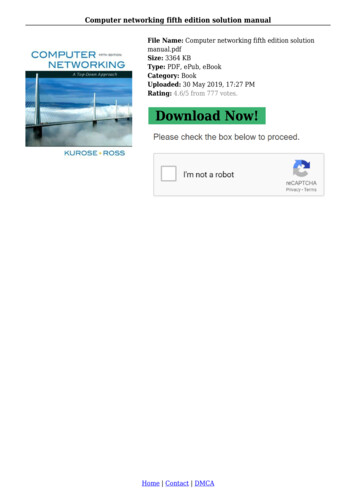
Transcription
CSC4200/5200 – COMPUTER NETWORKINGInstructor: Susmit ShannigrahiNETWORK SECURITY - CONTINUEDsshannigrahi@tntech.eduGTA: dereddick42@students.tntech.edu
Security RoadmapWhat is network security?Principles of cryptographyMessage integrityAuthenticationSecuring TCP connections: SSLNetwork layer security: IPsecOperational security: firewalls and IDSNetwork Security2
What is network security?confidentiality:only sender, intended receiver should“understand” message contents––sender encrypts messagereceiver decrypts messageauthentication:sender, receiver want to confirm identity ofeach othermessage integrity:sender, receiver want to ensure messagenot altered (in transit, or afterwards) without detectionaccess and availability: services must be accessible andavailable to users3
Friends and enemies: Alice, Bob, Trudy Bob and Alice want to communicate “securely”Trudy may intercept, delete, add messagesAliceBobchanneldatasecuresenderdata, controlmessagesssecurereceiverdataTrudy4
Some example problems–––––eavesdrop: intercept messagesactively insert messages into connectionimpersonation: can fake (spoof) source address inpacket (or any field in packet)hijacking: “take over” ongoing connection byremoving sender or receiver, inserting himself in placedenial of service: prevent service from being used byothers (e.g., by overloading resources)5
Symmetric keycrypto: DESDES operationinitial permutation16 identical “rounds” offunction application, eachusing different 48 bits ofkeyfinal permutation6
Public key cryptographyK BBob’s publickeyK - Bob’s privateB keyplaintextmessage, mencryptionalgorithmciphertext BK (m)decryptionalgorithmplaintextmessage- Bm KB (K (m))7
RoadmapWhat is network security?Principles of cryptographyMessage integrityAuthenticationSecuring TCP connections: SSLNetwork layer security: IPsecOperational security: firewalls and IDS8
AuthenticationGoal: Bob wants Alice to “prove” her identity to himProtocol ap1.0: Alice says “I am Alice”“I am Alice”Failure scenario?Network Security9
AuthenticationGoal: Bob wants Alice to “prove” her identity to himProtocol ap1.0: Alice says “I am Alice”“I am Alice”in a network,Bob can not “see” Alice, so Trudysimply declaresherself to be AliceNetwork Security10
Authentication: another tryProtocol ap2.0: Alice says “I am Alice” in an IP packetcontaining her source IP addressAlice’sIP address“I am Alice”Failure scenario?Network Security11
Authentication: another tryProtocol ap2.0: Alice says “I am Alice” in an IP packetcontaining her source IP addressAlice’sIP addressTrudy can createa packet “spoofing”Alice’s address“I am Alice”Network Security12
Authentication: another tryProtocol ap3.0: Alice says “I am Alice” and sends hersecret password to “prove” it.Alice’sIP addrAlice’spassword“I’m Alice”Alice’sIP addrOKFailure scenario?Network Security13
Authentication: another tryProtocol ap3.0: Alice says “I am Alice” and sends hersecret password to “prove” it.Alice’sIP addrAlice’spassword“I’m Alice”Alice’sIP addrAlice’sIP addrOKAlice’spasswordplayback attack: Trudy records Alice’spacketand laterplays it back to Bob“I’m Alice”Network Security14
Authentication: yet another tryProtocol ap3.1: Alice says “I am Alice” and sends herencrypted secret password to “prove” it.Alice’sIP addrencryptedpassword“I’m Alice”Alice’sIP addrOKFailure scenario?Network Security15
Authentication: yet another tryProtocol ap3.1: Alice says “I am Alice” and sends herencrypted secret password to “prove” it.Alice’sIP addrencryptedpassword“I’m Alice”Alice’sIP addrAlice’sIP addrrecordandplaybackstill works!OKencryptedpassword“I’m Alice”Network Security16
Authentication: yet another tryGoal: avoid playback attacknonce: number (R) used only once-in-a-lifetimeap4.0: to prove Alice “live”, Bob sends Alice nonce, R. Alicemust return R, encrypted with shared secret key“I am Alice”RKA-B (R)Alice is live, and only Aliceknows key to encrypt nonce,so it must be Alice!Failures, drawbacks?Network Security17
Authentication: ap5.0ap4.0 requires shared symmetric key can we authenticate using public key techniques?ap5.0: use nonce, public key cryptography“I am Alice”RKA(R)“send me your public key”K ABob computes K A (KA (R)) Rand knows only Alice could have theprivate key, that encrypted R suchthat KA(K (R)) RA18Network Security
ap5.0: security holeman (or woman) in the middle attack: Trudy poses as Alice (toBob) and as Bob (to Alice)I am AliceI am AliceRRK (R)TSend me your public keyK (R)A KTSend me your public keyK m K (K (m))AA K (m)A ATrudy gets m K (K (m))TTsends m to Aliceencrypted with Alice’spublic key K (m)TNetwork Security19
ap5.0: security holeman (or woman) in the middle attack: Trudy poses as Alice (toBob) and as Bob (to Alice)difficult to detect: Bobreceives everything that Alice sends, and vice versa. problem is that Trudy receives all messages as well!Network Security20
RoadmapWhat is network security?Principles of cryptographyMessage integrityAuthenticationSecuring TCP connections: SSLNetwork layer security: IPsecOperational security: firewalls and IDS21
SSL: Secure Sockets Layer widelydeployed security protocol supported by almost all browsers, webservers https billions /year over SSL mechanisms:[Woo 1994],implementation: Netscape variation -TLS: transport layersecurity, RFC 2246 provides confidentiality integrity authentication originalgoals: Web e-commerce transactions encryption (especially creditcard numbers) Web-server authentication optional client authentication minimum hassle in doingbusiness with new merchant available to all TCP applications secure socket interfaceNetwork Security22
SSL and TCP/IPApplicationApplicationSSLTCPIPnormal application TCPIPapplication with SSLSSL provides application programming interface(API) to applicationsC and Java SSL libraries/classes readily availableNetwork Security23
Could do something like PGP:m.H( )KAKA(H(m)).KA ( ) .KS( )mKS KS. KB ( ) KB Internet KB(KS )but want to send byte streams & interactive datawant set of secret keys for entire connectionwant certificate exchange as part of protocol: handshake phaseNetwork Security24
Real SSL: handshake (1)Purpose1. server authentication2. negotiation: agree on crypto algorithms3. establish keys4. client authentication (optional)Network Security25
Real SSL: handshake (2)1.2.3.4.5.6.client sends list of algorithms it supports, along with clientnonceserver chooses algorithms from list; sends back: choice certificate server nonceclient verifies certificate, extracts server’s public key,generates pre master secret, encrypts with server’s publickey, sends to serverclient and server independently compute encryption andMAC keys from pre master secret and noncesclient sends a MAC of all the handshake messagesserver sends a MAC of all the handshake messagesNetwork Security26
Real SSLconnectioneverythinghenceforthis encryptedTCP FIN followsNetwork Security27
SSL record protocoldatadatafragmentrecordheaderencrypteddata and MACdatafragmentMACrecordheaderMACencrypteddata and MACrecord header: content type; version; lengthMAC: includes sequence number, MAC key Mxfragment: each SSL fragment 214 bytes ( 16 Kbytes)Network Security28
Application and SSLCisco.com29
SSL and -middle-attacks-arp-part4/30
RoadmapWhat is network security?Principles of cryptographyMessage integrityAuthenticationSecuring TCP connections: SSLNetwork layer security: VPN and IPsecOperational security: firewalls and IDS31
What is network-layer confidentiality ?between two network entities: sending entity encrypts datagram payload, payloadcould be:– all data sent from one entity to other would behidden:– TCP or UDP segment, ICMP message, OSPF message .web pages, e-mail, P2P file transfers, TCP SYN packets “blanket coverage”Network Security32
Virtual Private Networks (VPNs)motivation: institutions often want private networks forsecurity.–costly: separate routers, links, DNS infrastructure. VPN:institution’s inter-office traffic is sent overpublic Internet instead––encrypted before entering public Internetlogically separate from other trafficNetwork Security33
Virtual Private Networks (VPNs)laptopw/ IPsecpublicInternetsalespersonin hotelrouter w/IPv4 and IPsecheadquartersrouter w/IPv4 and IPsecbranch officeNetwork Security34
IPsec services data integrityorigin authenticationreplay attack preventionconfidentialitytwo protocols providing different service models:––AHESPNetwork Security35
IPsec transport modeIPsec IPsecIPsec datagram emitted and received by end-systemprotects upper level protocolsNetwork Security36
IPsec – tunneling modeIPsec IPsecedge routers IPsecawareIPsecIPsec hosts IPsec-awareNetwork Security37
Two IPsec protocols Authentication Header (AH) protocol– provides source authentication & data integrity butnot confidentialityEncapsulation Security Protocol (ESP)––provides source authentication, data integrity, andconfidentialitymore widely used than AHNetwork Security38
Four combinations are possible!Host modewith AHHost modewith ESPTunnel modewith AHTunnel modewith ESPmost common andmost importantNetwork Security39
IPsec datagramfocus for now on tunnel mode with ESP“enchilada” authenticatedencryptednew IPheaderESPhdrSPIoriginalIP hdrSeq#Original IPdatagram ork Security40
What happens?Internetheadquarters200.168.1.100branch office193.68.2.23security �� authenticatedencryptednew IPheaderESPhdrSPIoriginalIP hdrSeq#Original IPdatagram ork Security41
RoadmapWhat is network security?Principles of cryptographyMessage integrityAuthenticationSecuring TCP connections: SSLNetwork layer security: VPN and IPsecOperational security: firewalls and IDS42
Firewallsfirewallisolates organization’s internal net from larger Internet,allowing some packets to pass, blocking otherspublicInternetadministerednetworktrusted “good guys”firewalluntrusted “bad guys”Network Security43
Firewalls: whyprevent denial of service attacks: SYN flooding: attacker establishes many bogus TCP connections,no resources left for “real” connectionsprevent illegal modification/access of internal data e.g., attacker replaces CIA’s homepage with something elseallow only authorized access to inside network set of authenticated users/hoststhree types of firewalls: stateless packet filters stateful packet filters application gatewaysNetwork Security44
Stateless packet filteringShould arriving packet beallowed in? Departing packetlet out? internal network connected to Internet via router firewallrouter filters packet-by-packet, decision to forward/droppacket based on:– source IP address, destination IP address– TCP/UDP source and destination port numbers– ICMP message type– TCP SYN and ACK bitsNetwork Security45
Stateless packet filtering: example example 1: block incoming and outgoing datagrams with IPprotocol field 17 and with either source or dest port 23– result: all incoming, outgoing UDP flows and telnetconnections are blockedexample 2: block inbound TCP segments with ACK 0.– result: prevents external clients from making TCPconnections with internal clients, but allows internalclients to connect to outside.Network Security46
Stateless packet filtering: more examplesPolicyFirewall SettingNo outside Web access.Drop all outgoing packets to any IP address, port80No incoming TCP connections, except those forinstitution’s public Web server only.Drop all incoming TCP SYN packets to any IPexcept 130.207.244.203, port 80Prevent Web-radios from eating up the availablebandwidth.Drop all incoming UDP packets - except DNS androuter broadcasts.Prevent your network from being used for a smurf Drop all ICMP packets going to a “broadcast”DoS attack.address (e.g. 130.207.255.255).Prevent your network from being traceroutedDrop all outgoing ICMP TTL expired trafficNetwork Security47
Access Control Lists ACL: table of rules, applied top to bottom to incomingpackets: (action, condition) utside of222.22/16allowoutside of222.22/16allow222.22/16allowoutside of222.22/16222.22/16denyallall222.22/16outside of222.22/16protocolsourceportdestportflagbitTCP 102380TCP80 1023ACKUDP 102353---UDP53 1023----allallallallanyNetwork Security48
Stateful packet filtering stateless packet filter: heavy handed tool–admits packets that “make no sense,” e.g., dest port 80, ACKbit set, even though no TCP connection established:actionallow sourceaddressdestaddressoutside bitTCP80 1023ACKstateful packet filter: track status of every TCP connection track connection setup (SYN), teardown (FIN): determine whetherincoming, outgoing packets “makes sense” timeout inactive connections at firewall: no longer admit packetsNetwork Security49
Stateless packet filtering: problemsIf network security interests you: https://nmap.org/book/50
Stateful packet filtering ACL augmented to indicate need to check connection statetable before admitting tdestportallow222.22/16outside of222.22/16TCP 102380allowoutside of222.22/16TCP80 1023ACKallow222.22/16UDP 102353---allowoutside of222.22/16222.22/16UDP53 1023----denyallallallallallall222.22/16outside of222.22/16flagbitcheckconxionanyxxNetwork Security51
Application gatewayshost-to-gatewaytelnet session filters packets on applicationdata as well as on IP/TCP/UDPfields.example: allow select internalusers to telnet outside.applicationgatewaygateway-to-remotehost telnet sessionrouter and filter1. require all telnet users to telnet through gateway.2. for authorized users, gateway sets up telnet connection todest host. Gateway relays data between 2 connections3. router filter blocks all telnet connections not originating fromgateway.Network Security52
Application gateways filter packets on applicationdata as well as on IP/TCP/UDPfields.example: allow select internalusers to telnet outsidehost-to-gatewaytelnet sessionapplicationgatewayrouter and filtergateway-to-remotehost telnet session1. require all telnet users to telnet through gateway.2. for authorized users, gateway sets up telnet connection todest host. Gateway relays data between 2 connections3. router filter blocks all telnet connections not originating fromgateway.Network Security53
Limitations of firewalls, gateways IP spoofing: router can’tknow if data “really” comesfrom claimed sourceif multiple app’s. needspecial treatment, each hasown app. gatewayclient software must knowhow to contact gateway.– e.g., must set IP addressof proxy in Web browser filters often use all ornothing policy for UDPtradeoff: degree ofcommunication with outsideworld, level of securitymany highly protected sitesstill suffer from attacksNetwork Security54
Intrusion detection systems packet filtering:–– operates on TCP/IP headers onlyno correlation check among sessionsIDS: intrusion detection system––deep packet inspection: look at packet contents (e.g.,check character strings in packet against database ofknown virus, attack strings)examine correlation among multiple packets port scanning network mapping DoS attackNetwork Security55
Intrusion detection systems multiple IDSs: different types of checking atdifferent k Security56
Honeypots mechanism set to detect, deflect unauthorized use of systems.57
Network Security (summary)basic techniques .–––cryptography (symmetric and public)message integrityend-point authentication . used in many different security scenarios––––secure emailsecure transport (SSL)IP sec802.11operational security: firewalls and IDSNetwork Security58
3 What is network security? confidentiality: only sender, intended receiver should "understand" message contents - sender encrypts message - receiver decrypts message authentication: sender, receiver want to confirm identity of each other message integrity: sender, receiver want to ensure message not altered (in transit, or afterwards) without detection










